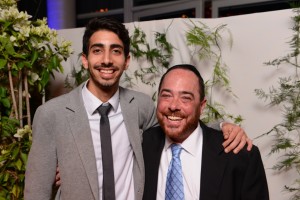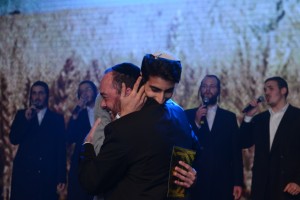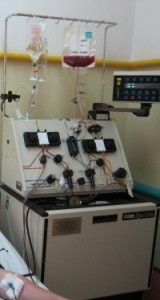A few months after his marriage, young Arik was diagnosed with Hodgkin’s Disease, a form of lymphoma, and his heart began to thrash with a confusion of feelings and thoughts.
Together with his new wife, Naomi Rivka, they had built their nest and fostered hopes and dreams for a shared Torah home, for a flourishing family life… Indeed, not long before, they had learned that soon, with G-d’s help, they would become parents. And now, suddenly – such a blow!
But Arik and Naomi did not allow themselves to be consumed by despair. They turned to doctors and were relieved to hear that Hodgkin’s is one of the forms of cancer with the highest chances of recovery.
They did not delude themselves that the journey ahead of them would be an easy one, but they prayed for Divine mercy and braced themselves for the many challenges awaiting them on the winding road that lay ahead.
Weeks and months passed. Arik received a variety of chemotherapy treatments followed by a course of radiation, and his heart was full of hope that the whole thing would soon be behind him.
The small hall where the crowd had gathered for the Bris of his firstborn was charged with emotion. “Baruch atah… she’hecheyanu… la’zeman hazeh – Blessed are You… for keeping us alive and maintaining us… to this time,” the father of the baby recited with trembling voice, in a double entendre – a blessing both on the mitzvah of brit milah and on the life he received as a gift with the cancer’s remission.
The newborn infant never imagined that the fact that his loving, smiling father was embracing him warmly was not something to be taken for granted…
But Abba Arik was determined to do anything necessary to regain his health. An autologous bone marrow transplant – a transplant of the patient’s own stem cells – put the illness into remission, but soon enough, it became clear that this was no more than a temporary reprieve.
“At this stage, we were told that our greatest hope would be to find a matching bone marrow donor for bone marrow transplant, Arik relates. “We turned to Rambam Hospital, and after a few days’ wait that felt like an eternity, we were told that a matching donor had been located via Ezer Mizion’s Registry, and not only that, but the donor was right here in Israel!”
On Purim of 5769 (2009), on the day that is earmarked for “V’nahofuch hu” – turnarounds, Arik’s mazel turned around, and with G-d’s help, he underwent the transplant successfully.
“In keeping with protocol, we did not know the identity of the donor,” he explains, “but we knew that thanks to him, we were given a new lease on life. My heart soared with a feeling of appreciation towards this Jew. As an expression of gratitude for the Jewish sense of mutual responsibility that saved my life, my wife and I tried to fill our lives with spiritual work.
“In the summer of 5770 (2010), we were divinely blessed with a double gift – twins, a boy and a girl. With deep emotion and endless appreciation, we gathered these marvelous gifts into our arms and our hearts harbored great hopes for the future.”
But then, yes, once again, they were confronted with test results that indicated – the cancer had returned.
This time too, Arik and Naomi did not lose hope. The very same anonymous donor gave another bone marrow donation. Success! Arik’s tiny blessings will grow up with a father, with G-d’s help.
Saving a Jewish Life
On the other side, Itzik Chogi’s story is no less fascinating. “Back then, when I joined Ezer Mizion’s Bone Marrow Registry, the procedure involved donating a sample of five ml. of blood,” he recalls. “The process of giving the sample was short and sweet, but still, it remained engraved in my consciousness, and I did not forget it. The knowledge that I had the potential to save a life in such a simple way appeared to me like a minor miracle, and every time I thought about it, I got the chills all over again. 
“My father Yosef z”l passed away when I was seventeen years old. I know what it means to lose a father and what a person would be willing to do so as not to lose a close family member. The findings of my blood sample were filed in Ezer Mizion’s International Registry among tens of thousands of others, and I waited eagerly for a call that I was found to be a good match for a donation.
“When I got the call from Ezer Mizion’s Bone Marrow Registry informing me that I was found to be a suitable match to donate bone marrow to a patient needing a transplant, I was gripped by emotion.
“Can you imagine?” he shared his feelings. “Just a year and a half had passed since my father passed away, and here, I would have the chance to save a life in his memory! I did not know whom I was going to be donating to, but I already felt a deep personal connection to that unknown person, to whom G-d had connected me with such a remarkable blood bond.”
Itzik was told that a bone marrow donor must be identical to the recipient in the tissue type characteristic known as “HLA proteins.” Even though close family members have the highest chance of being an HLA match, in practice, only about 30% of patients manage to find a matching donor among their blood relatives.
Due to the almost unlimited number of possible HLA combinations, the chances of finding a match between two people who are not related to each other are almost nil. These transplants are made possible only thanks to the existence of computerized international bone marrow registries, such as that of Ezer Mizion, which was the agent to find Itzik for Arik.
With deep excitement and the knowledge that he was privileged to do something that not many people have the opportunity to do, Itzik began the donation procedure.
For four days, he received injections to stimulate increased production of stem cells in his bone marrow and “inject” them into the peripheral blood stream. On Thursday, he arrived at Schneider Medical Center to undergo the harvesting of his stem cells, a simple procedure similar to a routine blood donation: Blood was drawn from him through a needle inserted in a vein of one arm. The blood was sent through a special machine that separated out the young stem cells collecting them in a small plastic bag (300 cc.), and then, the rest of the blood was returned to his body via a needle inserted into a vein of the other arm.
“I lay there for a few hours and underwent the donation process, without anesthesia, without pain, and without side effects,” he reports. In practice, Itzik, like all other bone marrow donors, did not lose any blood at all; the young stem cells that were screened from his bloodstream replenished themselves quickly, within a day.
“I came home very excited, praying that my stem cells that were transplanted into the body of the anonymous patient would be well accepted and save his life.”
Blood Brothers
Was the transplant a success? Did the recipient recover? Is he alive and well? Itzik asked himself these questions many times after the first donation, and many more times after the second transplant.
Who donated his bone marrow to me, and then did so again a second time? Who is the man to whom I owe my life? Arik, on his part, asked himself time and again.
Many dramatic meetings take place in Ezer Mizion branches across the country, when bone marrow transplants arranged by the organization’s intervention are crowned with success. Emotions rise to a head at the encounter of donor and recipient, crossing all lines. No one can remain unmoved upon seeing the meeting of two Jews who do not know each other, yet are joined by a covenant of “blood touched blood.”
All the terrifying moments of the illnesses, the nightmares, and horrific scenarios of those days rise before their eyes, followed by memories of throbbing hopes cutting through the air and bearing the promise of good news.
This time, the meeting took place in the presence of hundreds of teary-eyed observers, at a dinner held in Sivan 5773 (2013) on behalf of Ezer Mizion. On stage stood Arik Must who told his moving tale. When he finished, the emcee of the evening came over to him and gently asked, “Do you want to meet your donor?”
“I am waiting for this for almost three years!” Arik replied, barely able to conceal the emotion in his voice.
Without hesitation, the emcee turned to the audience and invited Mr. Itzik Chogi to step up to the stage.
The moment Arik and Itzik saw each other, they fell into each other’s arms excitedly, blinking back the tears that gleamed in the corners of their eyes. They paused to take a good look at each other, and then each embraced his dear ‘brother’ once again. It was hard to say who was happier – the donor or the recipient. But there is no doubt that the entire audience was swept up in the tremendous wave of emotion that could barely be contained.
Increasing the Chances
“This one benefits and the other does not lose.” With this sentence, Dr. Bracha Zisser, Director of Ezer Mizion’s International Bone Marrow Donor Registry and the Oranit Guest House for Cancer Patients and Cancer Patient Support Services, sums up the essence of a bone marrow donation.
“A bone marrow donation is like a candle that illuminates the soul of the next person without affecting the quality of the donor’s life in any way, without his soul losing even the slightest bit. When you kindle one candle from another, the light merely intensifies. There is no greater feeling in the world than knowing that a Jew is alive today thanks to you.”
Ezer Mizion’s International Bone Marrow Donor Registry was founded in 5758 (1998). As of now, the Registry includes more than 700,000 potential donors and is the largest Jewish Bone Marrow Donor Registry in the world. The Registry is conducted by the professional and dedicated hands of Dr. Bracha Zisser, with the important help of Ofra Konikoff, Chief Transplant Coordinator and Nira Shriki, Search and Transplant Supervisor. Every year, Jewish cancer patients from around the world turn to the Registry with search requests. Up until now, more than 1600 life-saving bone marrow transplants have taken place thanks to the Ezer Mizion Registry in medical centers in Israel and across the globe.
Use of bone marrow transplants as a cure for various illnesses began nearly 40 years ago. Since then, significant improvements have been made in this medical procedure and its application has become common and widespread. Today, bone marrow transplants assist in treatment of some 100 different diseases, including leukemia, lymphoma, other cancerous diseases, malignant blood diseases, auto-immune diseases, and hereditary illnesses.
Most patients with these conditions recover with the help of chemotherapy and radiation treatments. Nevertheless, there are some cases in which, without a bone marrow transplant, the chances of recovery are very slim.
Likelihood of a match rises significantly when the patient and the donor share a common genetic background. For generations, the Jewish people lived in closed communities, preserving the genetic similarity of its members. For this reason, there is greater genetic similarity between two unrelated Jews than between a Jew and a non-Jew. The international registry stationed in Holland lists more than 42 million potential donors, but only a small percentage of them are of Jewish ethnic background, and therefore, Jews have a poor chance of finding a matching donor there.
Ezer Mizion’s International Bone Marrow Donor Registry is annexed to the International Registry in Holland and has a reputation as a Registry that provides a speedy, efficient response. Every year, the Registry receives hundreds of search requests from transplant centers throughout the world. When a match is found, the bone marrow is delivered via Ezer Mizion to any destination necessary.
“The Registry is a vital infrastructure, a life-saving resource for hundreds of Jews desperately in need of a bone marrow donation,” says Dr. Bracha Zisser, Director of the Registry. “About ten percent of cancer patients require a bone marrow transplant at some stage and none of us is immune to cancer. For this reason, the Registry is like an insurance policy for every Jew, no matter who and no matter where,” she adds.
And of this we pray to always be counted among the givers and not the takers, the donors and not the recipients…
Ezer Mizion
World's Largest Jewish Bone Marrow Registry
